Created c. 1100 | ||
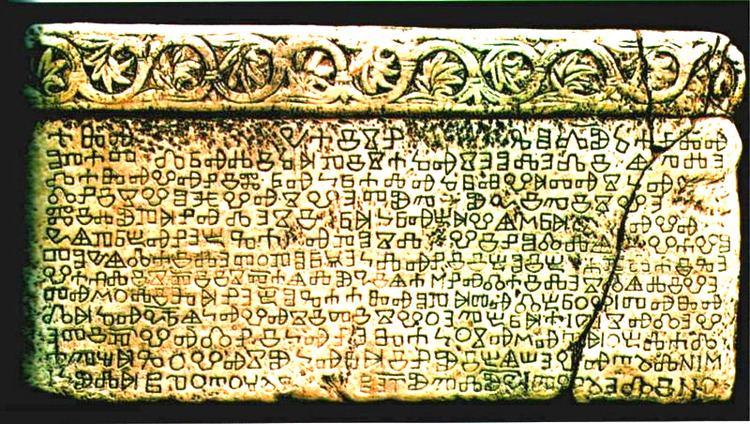 | ||
Purpose King Zvonimir's donation | ||
Baška tablet (Croatian: Bašćanska ploča, [bâʃt͡ɕanskaː plɔ̂t͡ʃa]) is one of the first monuments containing an inscription in the Croatian recension of the Church Slavonic language, dating from c. 1100.
Contents
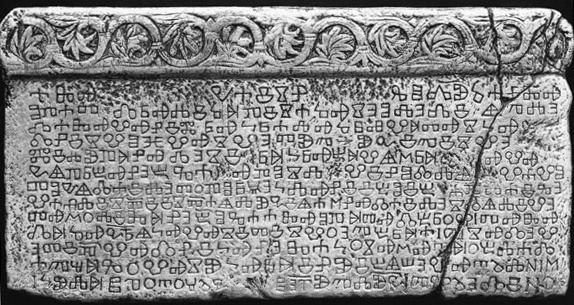
History
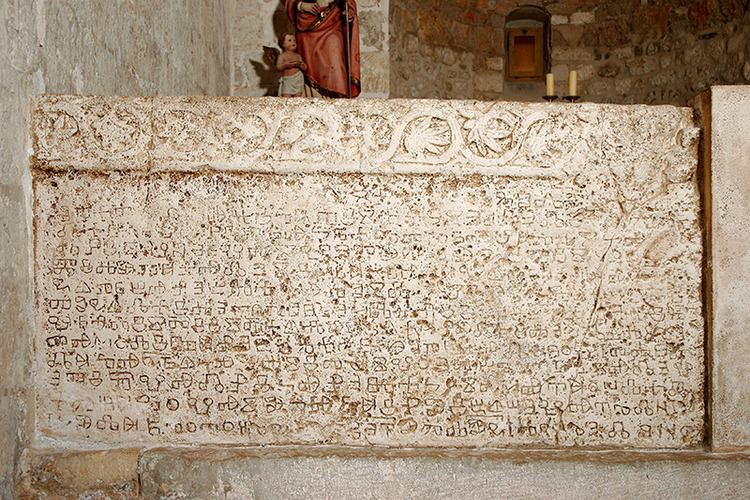
The tablet was discovered by scholars in 1851 in the paving of the Church of St. Lucy, Jurandvor near Baška on the island of Krk.
Since 1934 the original has been kept in the Croatian Academy of Sciences and Arts, Zagreb.
Description

Baška tablet is made of white limestone. It is 199 cm wide, 99.5 cm high, and 7.5–9 cm thick. It weighs approximately 800 kilograms.
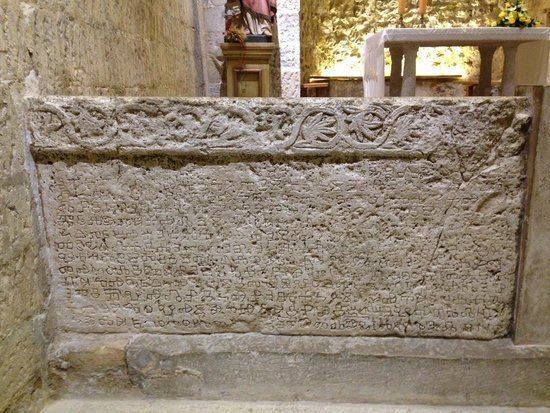
The inscribed stone slab records King Zvonimir's donation of a piece of land to a Benedictine abbey in the time of abbot Držiha. The second half of the inscription tells how Abbot Dobrovit built the church along with nine monks. The inscription is written in the Glagolitic script, exhibiting features of Church Slavonic of Croatian recension, such as writing (j)u for (j)ǫ, e for ę, i for y, and using one jer only (ъ). It provides the only example of transition from Glagolitic of the rounded Bulgarian type to the angular Croatian alphabet.
Contents
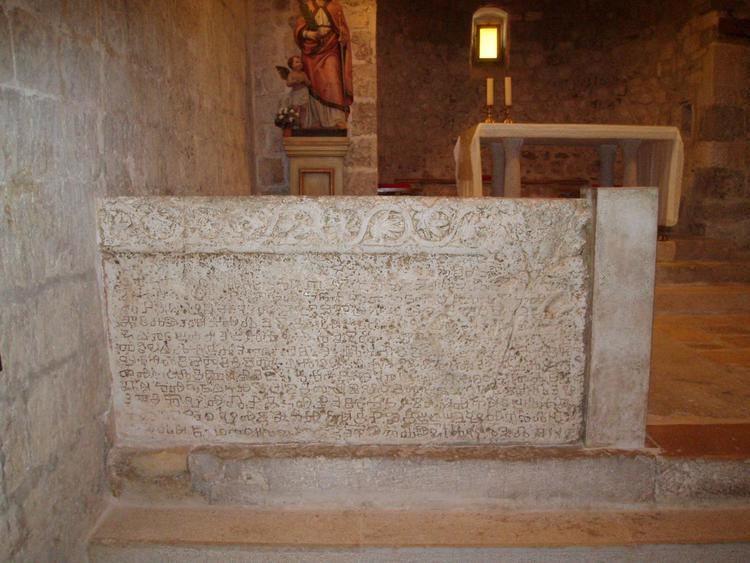
The scholars who took part in deciphering of the Glagolitic text had to deal with palaeographic challenges, as well as the problem of the damaged, worn-out surface of the slab. Through successive efforts, the contents was largely established before World War I, but remained a topic of study throughout the 20th century.
The original text:
ⰰⰸⱏ–––––ⱌⰰⱄⰻⱀⰰ––ⱅⰰⰳⱁⰴⱆⱈⰰⰰⰸⱏ
ⱁⱂⰰⱅ–ⰴⱃⱏⰶⰻⱈⱝⱂⰻⱄⰰⱈⱏⱄⰵⱁⰾⰵⰴⰻⱑⱓⰶⰵ
ⰴⰰⰸⱏⰲⱏⱀⰻⰿⱃⱏⰽⱃⰰⰾⱏⱈⱃⱏⱝⱅⱏⱄⰽⱏ–––
ⰴⱀⰻⱄⰲⱁⱗⰲⱏⱄⰲⰵⱅⱆⱓⰾⱆⱌⰻⱓⰻⱄⰲⰵ––
ⰿⰻⰶⱆⱂⱝⱀⱏⰴⰵⱄⰻ–ⱃⱝⰽⱃⱏⰱⱝⰲⱑⰿⱃⱝ–––ⱏⰲ––
ⱌⱑⱂⱃⰱⱏⱀⰵⰱⰳⰰ–ⱏⱂⱁⱄⰾ–ⰲⰻⱀⱁⰴⰾⱑ––ⰲⰰⰲⱁ
ⱅⱁⱌⱑⰴⰰⰻⰶⰵⱅⱉⱀⱁⱃⱒⰵⰽⰾⱏⱀⰻⰻⰱⱁⰻⰱ–ⰰⱀⰾⰰⰻⰳⰵ
ⰲⰰⰼⰾⰻⱄⱅ҃ⰻⰻⱄⱅ҃ⰰⱑⰾⱆⱌⰻⱑⰰⱞⱀⱏⰴⰰⰻⰾⰵⱄⰴⱑⰶⰻⰲⰵ
ⱅⱏⱞⱉⰾⰻⰸⱝⱀⰵⰱ҃ⱁⰳⰰⰰⰸⱏⱁⱀⱝⱅⱏⰴⰱⱃⱉⰲⱜⱅⱏⰸⱏ
ⰴⱝⱈⱏⱌⱃ꙯ⱑⰽⱏⰲⱏⱄⰻⱅⰻⱄⰲⱉⰵⱓⰱⱃⱝⰰⱜⱓⱄⱏⰴⰵⰲ
ⰵⱅⰻⱓⰲⱏⰴⱀⰻⰽⱏⱀⰵⰸⰰⰽⱉⱄⱏⱞⱏⱅⱝⱉⰱⰾⰰⰾ
ⰰⱓⱋⱝⰳⱉⰲⱏⱄⱆⰽⱏⱃⱝⰻⱀⱆⰻⰱⱑⱎⰵⰲⱏⱅⱏⰾNⱜⱞ
ⱜⰽⱆⰾⱝⰲⱏⱉтⱉⱒⱍ–––ⰲⰵт꙯ⱆⱓⰾⱆⱌ꙯ⱜⱓⰲⱏⰵⰾⰻNⱉ
The transliterated text, according to Branko Fučić, with restored segments in square brackets, is as follows:
Dating

The tablet's content suggests it was inscribed after the death of King Zvonimir in 1089, since abbot Držiha describes Zvonimir's donation as an event that happened further in the past ("in his days"). The Church of St. Lucy, described as having been built during the reign of prince Cosmas, indicates an era before the Venetian overlordship on Krk, starting in 1116. This, along with the Romanesque features of the church, dates the tablet in the late 11th or early 12th century, therefore c. 1100.
The meaning of the opening lines is contested. While some scholars interpret the introductory characters simply as Azъ ("I"), others believe that letters were also used to encode the year. There is no agreement, however, on the interpretation: 1100, 1077, 1079, 1105 and 1120 have been proposed.
Significance
The name Croatia and adjective Croatian are mentioned on the tablet for the first time in the Croatian language.
Despite the fact of not being the oldest Croatian Glagolitic monument (the Plomin tablet, Valun tablet, Krk inscription, are older and appeared in the 11th century) and in spite of the fact that it was not written in the pure Croatian vernacular - it has nevertheless been referred to by Stjepan Ivšić as "the jewel of the Croatian language" and "the baptismal certificate" of Croatian literary culture. It features a vaguely damaged ornamental string pattern, the Croatian interlace (troplet).
The tablet is depicted on the obverse of the Croatian 100 kuna banknote, issued in 1993 and 2002.
